Finance Principles: Capital Budgeting, Investment, and Portfolio
VerifiedAdded on 2022/08/28
|7
|1072
|39
Homework Assignment
AI Summary
This finance assignment solution addresses key concepts in financial management, including capital budgeting and portfolio analysis. Part 1 examines the relevance of costs in capital budgeting decisions, differentiating between sunk costs and opportunity costs, and evaluating the impact of depreciation. It then computes and interprets Net Present Value (NPV), payback period, and Internal Rate of Return (IRR) to assess project profitability. Part 2 focuses on investment choices, comparing stock returns and analyzing portfolio diversification through correlation coefficients, expected return and standard deviation. The assignment provides detailed calculations and interpretations to support financial decision-making, making it a comprehensive resource for finance students. This assignment is available on Desklib, a platform providing students with AI-based study tools.

Running head: INTRODUCTION TO FINANCE PRINCIPLES
Introduction to finance principles
Name of the student
Name of the university
Student ID
Author note
Introduction to finance principles
Name of the student
Name of the university
Student ID
Author note
Paraphrase This Document
Need a fresh take? Get an instant paraphrase of this document with our AI Paraphraser

1INTRODUCTION TO FINANCE PRINCIPLES
Table of Contents
Part 1..........................................................................................................................................2
Answer 1................................................................................................................................2
Answer 2................................................................................................................................2
Answer 3................................................................................................................................2
Part 2..........................................................................................................................................5
Answer 1................................................................................................................................5
Answer 2................................................................................................................................5
Answer 3................................................................................................................................5
Reference....................................................................................................................................6
Table of Contents
Part 1..........................................................................................................................................2
Answer 1................................................................................................................................2
Answer 2................................................................................................................................2
Answer 3................................................................................................................................2
Part 2..........................................................................................................................................5
Answer 1................................................................................................................................5
Answer 2................................................................................................................................5
Answer 3................................................................................................................................5
Reference....................................................................................................................................6
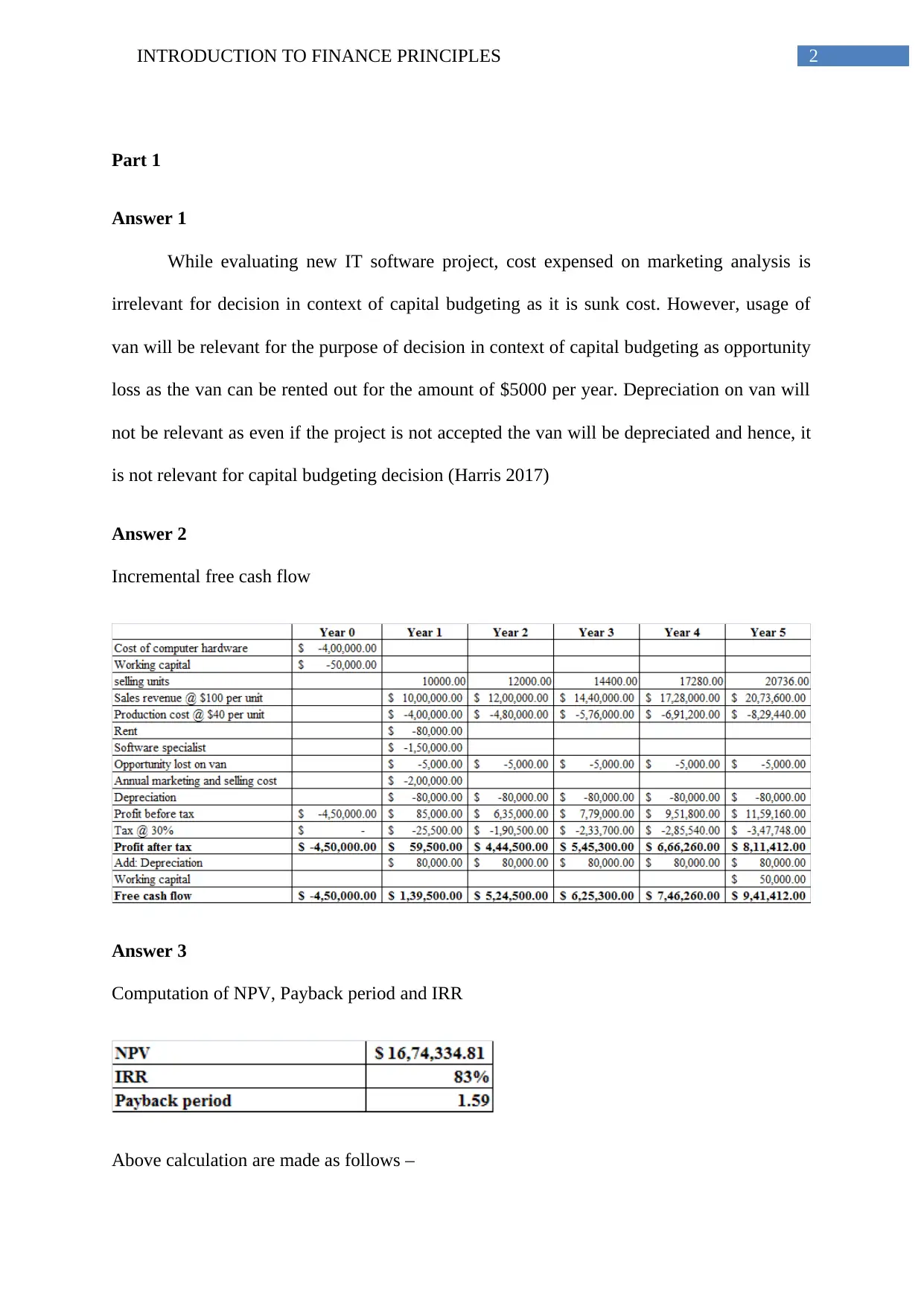
2INTRODUCTION TO FINANCE PRINCIPLES
Part 1
Answer 1
While evaluating new IT software project, cost expensed on marketing analysis is
irrelevant for decision in context of capital budgeting as it is sunk cost. However, usage of
van will be relevant for the purpose of decision in context of capital budgeting as opportunity
loss as the van can be rented out for the amount of $5000 per year. Depreciation on van will
not be relevant as even if the project is not accepted the van will be depreciated and hence, it
is not relevant for capital budgeting decision (Harris 2017)
Answer 2
Incremental free cash flow
Answer 3
Computation of NPV, Payback period and IRR
Above calculation are made as follows –
Part 1
Answer 1
While evaluating new IT software project, cost expensed on marketing analysis is
irrelevant for decision in context of capital budgeting as it is sunk cost. However, usage of
van will be relevant for the purpose of decision in context of capital budgeting as opportunity
loss as the van can be rented out for the amount of $5000 per year. Depreciation on van will
not be relevant as even if the project is not accepted the van will be depreciated and hence, it
is not relevant for capital budgeting decision (Harris 2017)
Answer 2
Incremental free cash flow
Answer 3
Computation of NPV, Payback period and IRR
Above calculation are made as follows –
⊘ This is a preview!⊘
Do you want full access?
Subscribe today to unlock all pages.

Trusted by 1+ million students worldwide
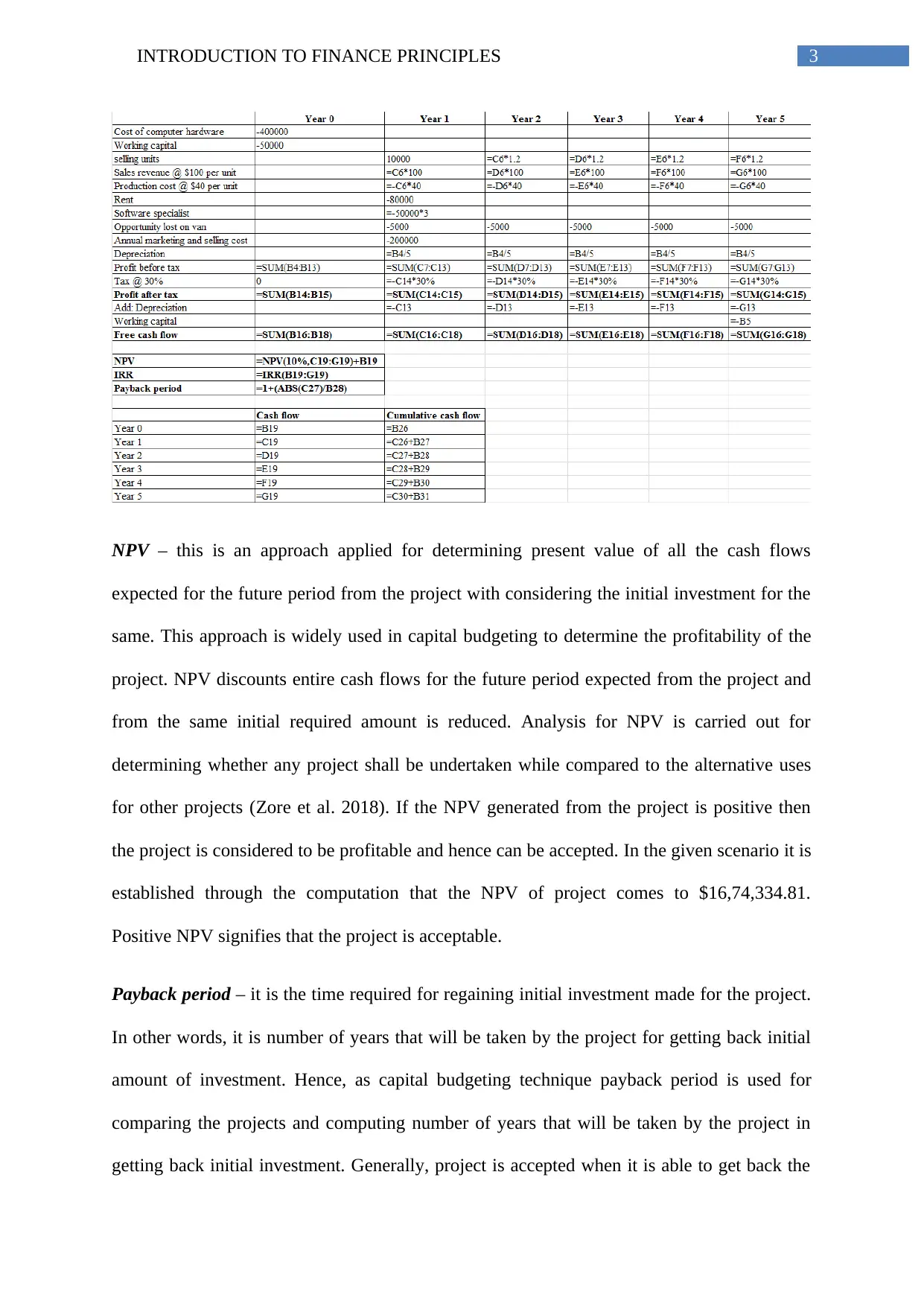
3INTRODUCTION TO FINANCE PRINCIPLES
NPV – this is an approach applied for determining present value of all the cash flows
expected for the future period from the project with considering the initial investment for the
same. This approach is widely used in capital budgeting to determine the profitability of the
project. NPV discounts entire cash flows for the future period expected from the project and
from the same initial required amount is reduced. Analysis for NPV is carried out for
determining whether any project shall be undertaken while compared to the alternative uses
for other projects (Zore et al. 2018). If the NPV generated from the project is positive then
the project is considered to be profitable and hence can be accepted. In the given scenario it is
established through the computation that the NPV of project comes to $16,74,334.81.
Positive NPV signifies that the project is acceptable.
Payback period – it is the time required for regaining initial investment made for the project.
In other words, it is number of years that will be taken by the project for getting back initial
amount of investment. Hence, as capital budgeting technique payback period is used for
comparing the projects and computing number of years that will be taken by the project in
getting back initial investment. Generally, project is accepted when it is able to get back the
NPV – this is an approach applied for determining present value of all the cash flows
expected for the future period from the project with considering the initial investment for the
same. This approach is widely used in capital budgeting to determine the profitability of the
project. NPV discounts entire cash flows for the future period expected from the project and
from the same initial required amount is reduced. Analysis for NPV is carried out for
determining whether any project shall be undertaken while compared to the alternative uses
for other projects (Zore et al. 2018). If the NPV generated from the project is positive then
the project is considered to be profitable and hence can be accepted. In the given scenario it is
established through the computation that the NPV of project comes to $16,74,334.81.
Positive NPV signifies that the project is acceptable.
Payback period – it is the time required for regaining initial investment made for the project.
In other words, it is number of years that will be taken by the project for getting back initial
amount of investment. Hence, as capital budgeting technique payback period is used for
comparing the projects and computing number of years that will be taken by the project in
getting back initial investment. Generally, project is accepted when it is able to get back the
Paraphrase This Document
Need a fresh take? Get an instant paraphrase of this document with our AI Paraphraser
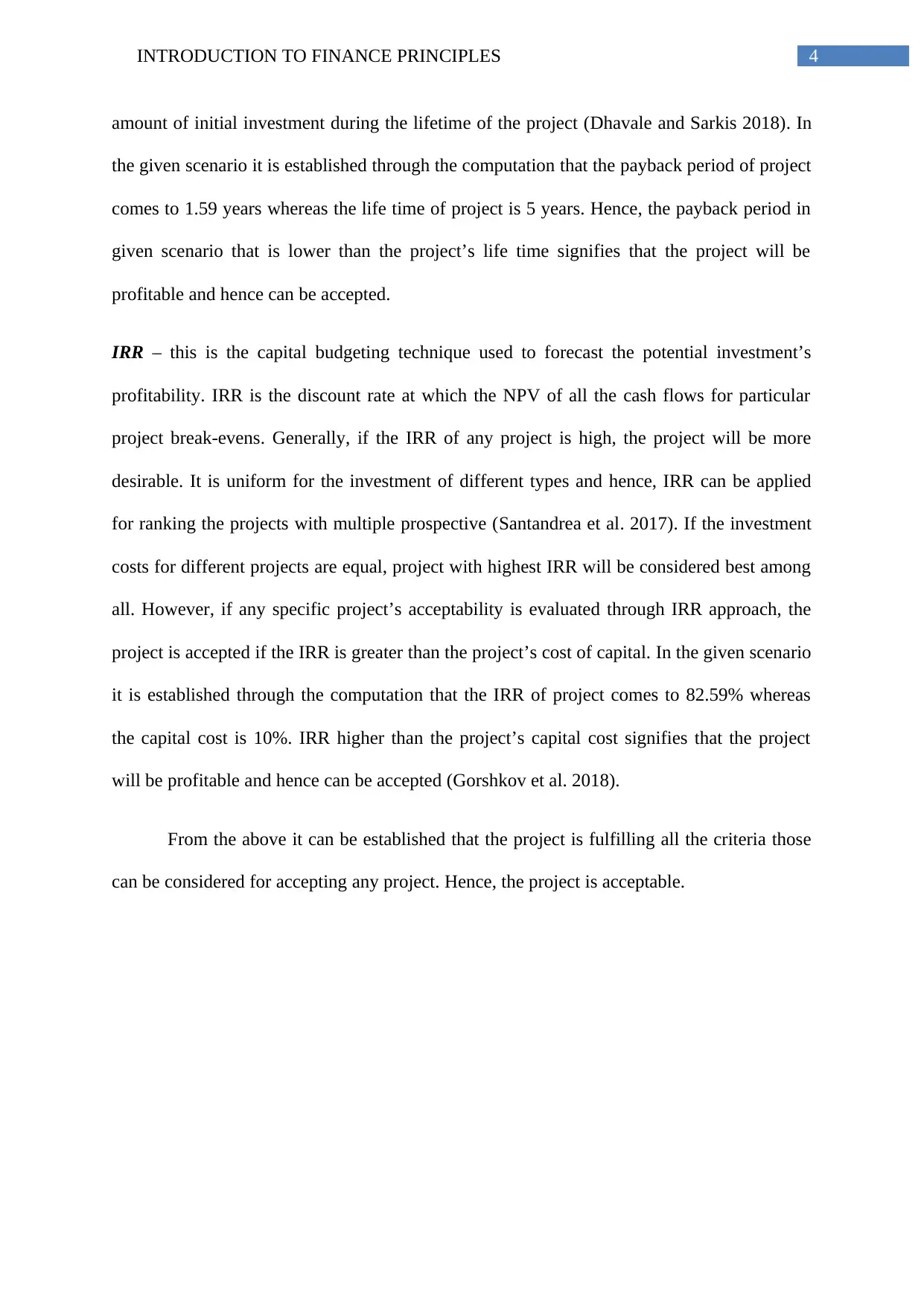
4INTRODUCTION TO FINANCE PRINCIPLES
amount of initial investment during the lifetime of the project (Dhavale and Sarkis 2018). In
the given scenario it is established through the computation that the payback period of project
comes to 1.59 years whereas the life time of project is 5 years. Hence, the payback period in
given scenario that is lower than the project’s life time signifies that the project will be
profitable and hence can be accepted.
IRR – this is the capital budgeting technique used to forecast the potential investment’s
profitability. IRR is the discount rate at which the NPV of all the cash flows for particular
project break-evens. Generally, if the IRR of any project is high, the project will be more
desirable. It is uniform for the investment of different types and hence, IRR can be applied
for ranking the projects with multiple prospective (Santandrea et al. 2017). If the investment
costs for different projects are equal, project with highest IRR will be considered best among
all. However, if any specific project’s acceptability is evaluated through IRR approach, the
project is accepted if the IRR is greater than the project’s cost of capital. In the given scenario
it is established through the computation that the IRR of project comes to 82.59% whereas
the capital cost is 10%. IRR higher than the project’s capital cost signifies that the project
will be profitable and hence can be accepted (Gorshkov et al. 2018).
From the above it can be established that the project is fulfilling all the criteria those
can be considered for accepting any project. Hence, the project is acceptable.
amount of initial investment during the lifetime of the project (Dhavale and Sarkis 2018). In
the given scenario it is established through the computation that the payback period of project
comes to 1.59 years whereas the life time of project is 5 years. Hence, the payback period in
given scenario that is lower than the project’s life time signifies that the project will be
profitable and hence can be accepted.
IRR – this is the capital budgeting technique used to forecast the potential investment’s
profitability. IRR is the discount rate at which the NPV of all the cash flows for particular
project break-evens. Generally, if the IRR of any project is high, the project will be more
desirable. It is uniform for the investment of different types and hence, IRR can be applied
for ranking the projects with multiple prospective (Santandrea et al. 2017). If the investment
costs for different projects are equal, project with highest IRR will be considered best among
all. However, if any specific project’s acceptability is evaluated through IRR approach, the
project is accepted if the IRR is greater than the project’s cost of capital. In the given scenario
it is established through the computation that the IRR of project comes to 82.59% whereas
the capital cost is 10%. IRR higher than the project’s capital cost signifies that the project
will be profitable and hence can be accepted (Gorshkov et al. 2018).
From the above it can be established that the project is fulfilling all the criteria those
can be considered for accepting any project. Hence, the project is acceptable.
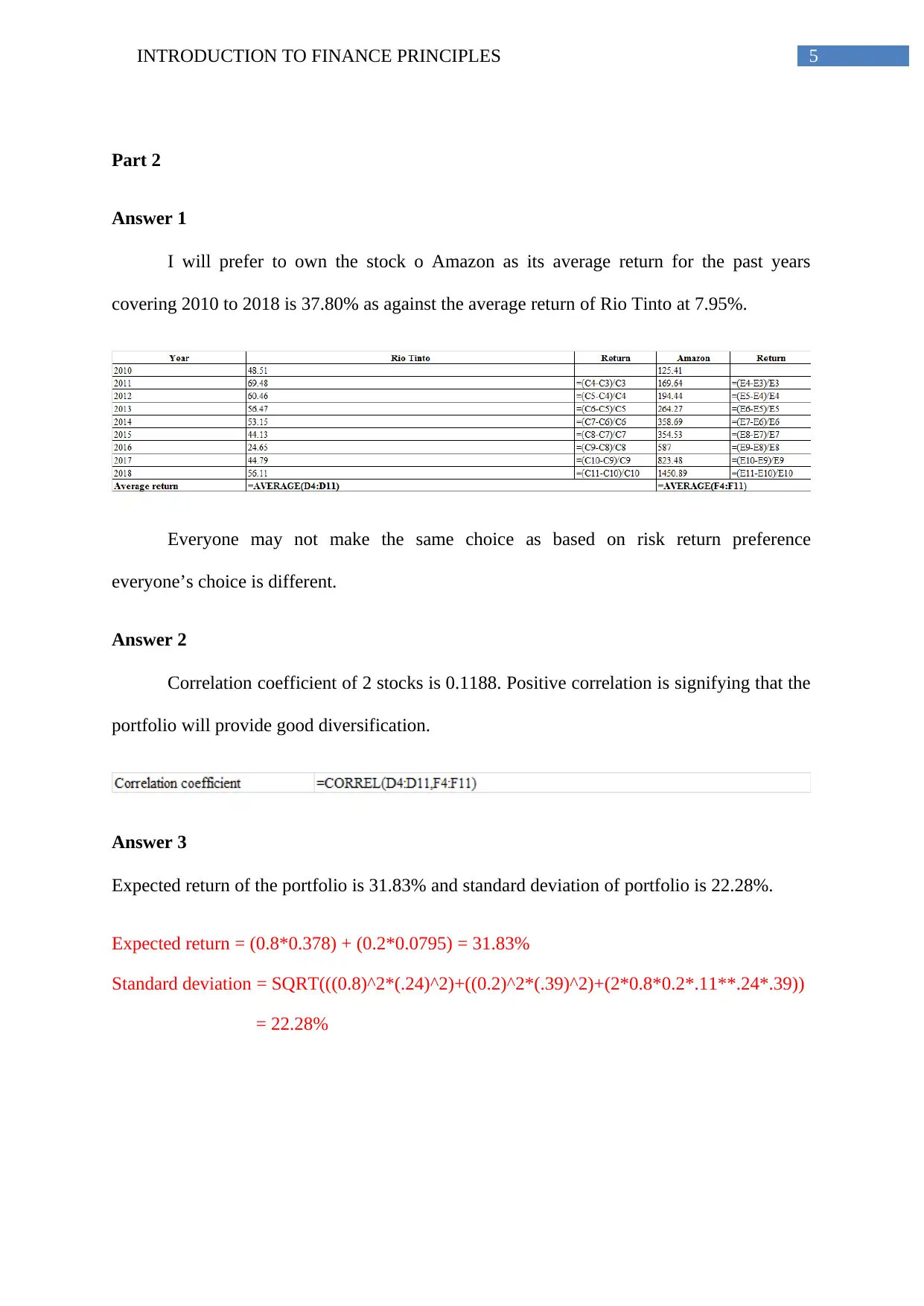
5INTRODUCTION TO FINANCE PRINCIPLES
Part 2
Answer 1
I will prefer to own the stock o Amazon as its average return for the past years
covering 2010 to 2018 is 37.80% as against the average return of Rio Tinto at 7.95%.
Everyone may not make the same choice as based on risk return preference
everyone’s choice is different.
Answer 2
Correlation coefficient of 2 stocks is 0.1188. Positive correlation is signifying that the
portfolio will provide good diversification.
Answer 3
Expected return of the portfolio is 31.83% and standard deviation of portfolio is 22.28%.
Expected return = (0.8*0.378) + (0.2*0.0795) = 31.83%
Standard deviation = SQRT(((0.8)^2*(.24)^2)+((0.2)^2*(.39)^2)+(2*0.8*0.2*.11**.24*.39))
= 22.28%
Part 2
Answer 1
I will prefer to own the stock o Amazon as its average return for the past years
covering 2010 to 2018 is 37.80% as against the average return of Rio Tinto at 7.95%.
Everyone may not make the same choice as based on risk return preference
everyone’s choice is different.
Answer 2
Correlation coefficient of 2 stocks is 0.1188. Positive correlation is signifying that the
portfolio will provide good diversification.
Answer 3
Expected return of the portfolio is 31.83% and standard deviation of portfolio is 22.28%.
Expected return = (0.8*0.378) + (0.2*0.0795) = 31.83%
Standard deviation = SQRT(((0.8)^2*(.24)^2)+((0.2)^2*(.39)^2)+(2*0.8*0.2*.11**.24*.39))
= 22.28%
⊘ This is a preview!⊘
Do you want full access?
Subscribe today to unlock all pages.

Trusted by 1+ million students worldwide
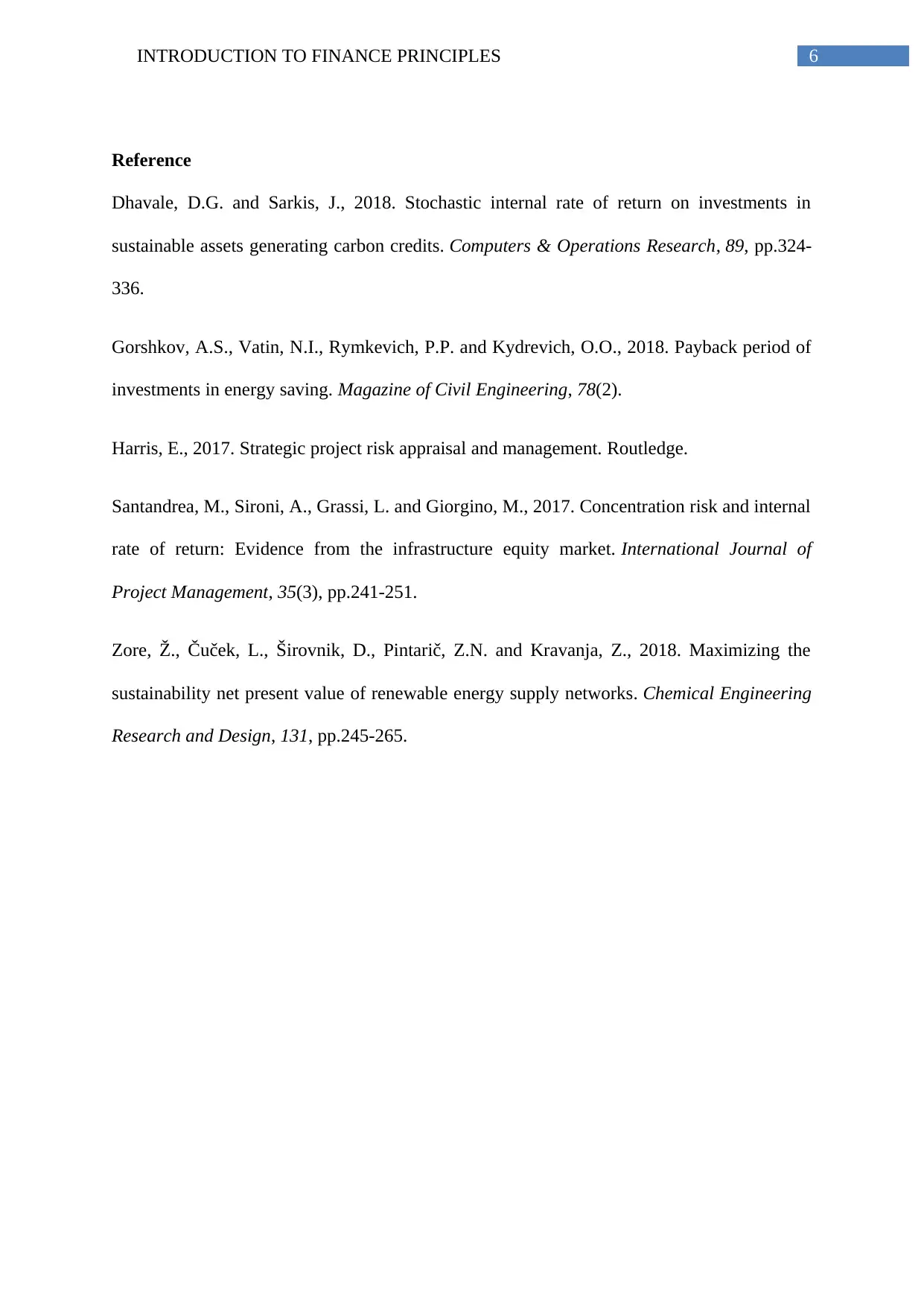
6INTRODUCTION TO FINANCE PRINCIPLES
Reference
Dhavale, D.G. and Sarkis, J., 2018. Stochastic internal rate of return on investments in
sustainable assets generating carbon credits. Computers & Operations Research, 89, pp.324-
336.
Gorshkov, A.S., Vatin, N.I., Rymkevich, P.P. and Kydrevich, O.O., 2018. Payback period of
investments in energy saving. Magazine of Civil Engineering, 78(2).
Harris, E., 2017. Strategic project risk appraisal and management. Routledge.
Santandrea, M., Sironi, A., Grassi, L. and Giorgino, M., 2017. Concentration risk and internal
rate of return: Evidence from the infrastructure equity market. International Journal of
Project Management, 35(3), pp.241-251.
Zore, Ž., Čuček, L., Širovnik, D., Pintarič, Z.N. and Kravanja, Z., 2018. Maximizing the
sustainability net present value of renewable energy supply networks. Chemical Engineering
Research and Design, 131, pp.245-265.
Reference
Dhavale, D.G. and Sarkis, J., 2018. Stochastic internal rate of return on investments in
sustainable assets generating carbon credits. Computers & Operations Research, 89, pp.324-
336.
Gorshkov, A.S., Vatin, N.I., Rymkevich, P.P. and Kydrevich, O.O., 2018. Payback period of
investments in energy saving. Magazine of Civil Engineering, 78(2).
Harris, E., 2017. Strategic project risk appraisal and management. Routledge.
Santandrea, M., Sironi, A., Grassi, L. and Giorgino, M., 2017. Concentration risk and internal
rate of return: Evidence from the infrastructure equity market. International Journal of
Project Management, 35(3), pp.241-251.
Zore, Ž., Čuček, L., Širovnik, D., Pintarič, Z.N. and Kravanja, Z., 2018. Maximizing the
sustainability net present value of renewable energy supply networks. Chemical Engineering
Research and Design, 131, pp.245-265.
1 out of 7
Related Documents
Your All-in-One AI-Powered Toolkit for Academic Success.
+13062052269
info@desklib.com
Available 24*7 on WhatsApp / Email
![[object Object]](/_next/static/media/star-bottom.7253800d.svg)
Unlock your academic potential
Copyright © 2020–2025 A2Z Services. All Rights Reserved. Developed and managed by ZUCOL.





